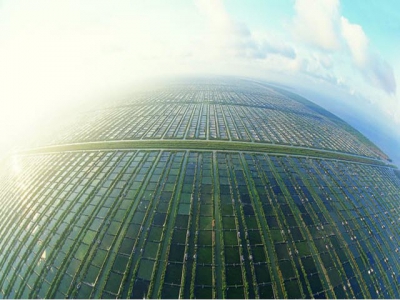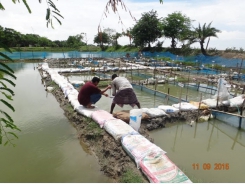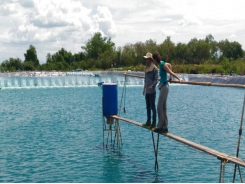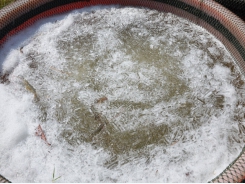From the micro to the macro: probiotics and biofloc systems positive impact on shrimps

One of South East Asia’s largest shrimp farming groups is the Lim Shrimp Organization (LSO), which has established a network of integrated farming projects known as Aqua Villages. In 2018, it completed 12 such projects in Indonesia, two in Thailand and one in Malaysia. All used sustainable farming principles including the use of probiotics and biofloc systems.
The world's largest shrimp farm, run by Lim Shrimp, in Indonesia. Photo © Lim Shrimp Organisation
This article takes a closer look at the underlying science and how microorganisms are paving the way for sustainable shrimp farms across Asia.
Shrimp farming is among the fastest-growing and most profitable sectors in aquaculture. Due to its popularity, the culture of shrimp has been marked by intensifying practices spurring more frequent disease outbreaks and crippling financial losses.
The traditional method of fighting shrimp disease is to use large amounts of antibiotics and chemicals, often prophylactically, an approach that comes with a host of problems including exorbitant costs and the unintended development of antibiotic resistance among pathogens.
By now many pathogens have become endemic to the coastal farming areas of South East Asia, with the shrimp farming sector losing an estimated US$45 billion to diseases in the past 10 years alone. To avoid these pitfalls, farmers have been searching for alternative ways to farm shrimp, with more natural production systems quickly gaining popularity as alternatives to current high-density monoculture systems. This smarter and more eco-friendly farming approach includes the use of fibrous prebiotics and probiotics, plus bioflocs.

The world's largest integrated shrimp farm, Indonesia. Photo © Lim Shrimp Organization
Pre- or pro-biotics?
Prebiotics are non-living feeds or feed ingredients, often of fibrous origin, that serve as a feed source for beneficial gut bacteria. Improved gut microbiota in turn helps animals metabolise and absorb more nutrients. Examples of prebiotics include garlic, bananas and beans. Farmers in Asia have a long history of using these food items as feed additives, typically without fully understanding the principles behind prebiotics.
To ensure quicker and better results, supplementary quantities of the beneficial bacteria, which are also known as probiotics, can be added directly to the feed alongside the prebiotic ingredients. This practice is already popular in human foods like yoghurt, pickles and kimchi, and probiotics’ use is becoming more mainstream in aquaculture as well.
Probiotics can be sourced from bacteria, red or brown algae and fungi and have been defined by Fuller in 1989 as “live microbial feed supplements which beneficially affect hosts by improving intestinal balance”. So far three bacterial genera, Bacillus, Vibrio and Pseudomonas, are mainly administered as probiotics in shrimp aquaculture, though yeast and lactic acid bacteria are also used.
Studies have established that improved metabolism and absorption of nutrients through the use of prebiotics and probiotics greatly improves the overall health, survival, growth rate and feed conversion ratio of shrimp.
Probiotics elevate innate shrimp defence mechanisms before or after exposure to dangerous pathogens and help shrimp overcome stressful conditions such as eyestalk ablation, vaccination, saltwater transfer, anti-parasite treatments, netting, handling and grading.
A study by Rengpipat et al. shows that the survival of probiotic-boosted black tiger shrimp (Penaeus monodon) affected by the pathogen Vibrio harveyi stood at a perfect 100 percent, while only 26 percent of shrimp reared without probiotics survived. A separate study by Moriarty reinforced this by analysing the use of Bacillus probiotics which allowed continuous penaeid shrimp culture for over 160 days. In contrast, farms that did not use probiotics experienced complete failure across all ponds within 80 days due to Vibrio disease.
A 2018 study furthermore found that the application of multiple-strain probiotics is more efficient than single strains at improving the growth and overall health of whiteleg shrimp (Litopenaeus vannamei). The study observed that the effects of using mixed probiotics containing Lactobacillus pentosus BD6, L. fermentum LW2, Bacillus subtilis E20 and Saccharomyces cerevisiae P13 were far better than the effects of single probiotics. However, prolonged application can induce immunosuppression and reduce overall effectiveness.
By improving digestion and food-conversation ratios, waste output is also reduced, making it easier to maintain the quality of the culture water. Some beneficial bacterial species, especially certain Bacillus strains and other nitrifying bacteria, can also be added directly to the culture water to improve the decomposition of waste materials, thereby lowering ammonia levels and the occurrence of blue-green algae, while indirectly further improving shrimp health and performance.

Lim Shrimp has adopted a more eco-friendly farming approach includes the use of fibrous prebiotics and probiotics, plus bioflocs. Photo © Lim Shrimp Organisation
Biofloc to recycle nutrients
Another way to utilise these beneficial microorganisms is through the application of biofloc systems, a wastewater-treatment technique that converts unused nutrients into food. As Dr Nyan Taw, a shrimp expert and FAO consultant from Myanmar, explains: “The biofloc principle stimulates the natural growth of macro-aggregate ‘flocs’ that enhance the self-nitrification of culture water. The process is normally initiated at the start of the culture process and takes a few weeks to complete, starting with the growth of algae, continuing with foam formation and eventually the growth of bioflocs.”
These flocs are comprised of beneficial (probiotic) bacteria, diatoms, protozoans, algae, fungi and other living organisms, typically held together by bacterial mucous. Most are microscopic but particularly large flocs look like sludge, which zooplankton and nematodes also feed on. All can be a supplemental food source which can be grazed by shrimp or finfish between feedings of pelleted diets. The biofloc system effectively uses microorganisms to recycle waste nutrients and augment the growth of aquacultured animals. Biofloc is eco-friendly, efficient and reduces the spread of pathogens while improving fish health via better water quality and improved feed quantity and availability. Since the system produces its own probiotics, farmers no longer need to keep buying probiotic products.
Many species and many unknowns
Shoaibe recently compiled an overview of the probiotic microorganisms that are already available and used in shrimp aquaculture in Bangladesh. Table 1 shows an impressive list of particular species and strains plus their applications. It must be noted, however, that the use of beneficial bacteria and other microorganisms is not an all-encompassing, silver bullet for shrimp aquaculture and there are still many unknowns to their application.
As Dr Taw explains: “We do not yet fully understand if and how the application of probiotics and biofloc technology works in large outdoor ponds, but several studies found that there are around 2,000 heterotrophic bacterial types already existing in natural pond water and I was told that a single species of bacteria cannot complete the nitrification process. Somehow these bacteria communicate with each other and complement each other to complete the process of nitrification.”
The future is bright
Despite these unknowns, Dr Taw believes that prospects for the future of shrimp farming in South East Asia are increasingly bright as biofloc principles are further incorporated by shrimp farms around the globe, with more sustainable practices being embraced.
Several of the dominant players in the shrimp farming sector in South East Asia seem to agree with him and have recently initiated new farming projects that incorporate biofloc and prebiotic principles. One of the largest shrimp farming groups in South East Asia is the Lim Shrimp Organization (LSO) which operates across Asia through large integrated farming projects and “shrimp farming villages”.
CEO, Djames Lim, explains that the organization’s motto is to turn countrymen and fishers who are living in poverty into aquapreneurs by teaching them how to culture economically viable shrimp, fish and any other species – and thereby raising real prospects that they will one day owning their own farm and land.
“Our organisation strongly believes in environmental protection and using sustainable methods to grow shrimp. We embrace a wholesome approach involving social, environmental and economic components,” he says.
Lim explains how using probiotics and biofloc principles is important to their success. The figures speak for themselves: in 2018, the company completed 12 LSO Aqua Village projects in Indonesia, two in Thailand and another in Malaysia. For 2019, the organisation secured contracts for another 50 projects across Asia, revealing the amount of interest there is in sustainable shrimp farming using natural principles, and its huge potential.
As more research is conducted and new ways of maximising the effects of probiotics are better understood, we can be sure that this field will have lots to offer in further reducing the environmental impacts, and boosting the productivity, of tomorrow’s shrimp farms – and in creating a sustainable future for shrimp farming in Asia.
Có thể bạn quan tâm
Phần mềm

Phối trộn thức ăn chăn nuôi

Pha dung dịch thủy canh

Định mức cho tôm ăn

Phối trộn phân bón NPK

Xác định tỷ lệ tôm sống

Chuyển đổi đơn vị phân bón

Xác định công suất sục khí

Chuyển đổi đơn vị tôm

Tính diện tích nhà kính

Tính thể tích ao hồ




 Least-cost formulation software in shrimp aquafeed production -…
Least-cost formulation software in shrimp aquafeed production -…  Least-cost formulation software in shrimp aquafeed production -…
Least-cost formulation software in shrimp aquafeed production -…